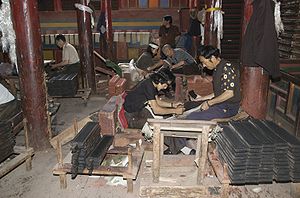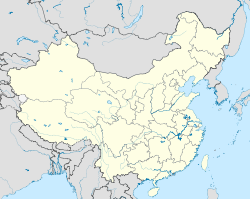- Gonchen Monastery
-
Gonden Monastery Coordinates: 31°34′19″N 98°20′49″E / 31.572°N 98.347°E Monastery information Location Sichuan, China Founded by Thang Tong Gyalpo (or Tangton Gyelpo)(1385-1464 CE) Founded 15th century Date renovated 1980s Type Tibetan Buddhist Sect Sakya Dedicated to Padmasambhava, Sakyamuni Buddha (Sakya Thukpa) and the future Buddha, Jampa or Maitreya Architecture The monastery has a notable design, with striped walls of white, dark red and gray, colors unique to the Sakya sect Part of a series on Tibetan Buddhism
History Timeline · Related-topics Schools Nyingma · Kagyu · Sakya · Gelug · Bön · Jonang Key concepts Three marks of existence · Skandha · Cosmology · Saṃsāra · Rebirth · Bodhisattva · Dharma · Dependent origination · Karma Major figures Gautama Buddha · Padmasambhava · Je Tsongkhapa · Dalai Lama · Panchen Lama · Lama · Karmapa Lama · Rinpoche · Geshe · Terton · Tulku Buddhahood · Avalokiteśvara · Four stages of enlightenment · Tantric yoga · Paramitas · Meditation · Laity Changzhug · Drepung · Dzogchen · Ganden · Jokhang · Kumbum · Labrang · Mindroling · Namgyal · Narthang · Nechung · Pabonka · Palcho · Ralung · Ramoche · Sakya · Sanga · Sera · Shalu · Tashilhunpo · Tsurphu · Yerpa Chotrul Duchen · Dajyur · Losar · Monlam · Sho Dun Texts Kangyur · Tengyur · Tibetan canon · Mahayana sutras · Nyingma Gyubum Sand mandala · Thangka · Ashtamangala · Tree of physiology Outline · Comparative studies · Culture · List of topics · Portal
Gonchen (also known as Dege Gonchen or Derge Monastery) is a large Sakya Tibetan Buddhist monastery in the town of Derge, in Sichuan, China. Historically this area was in Tibetan region of Kham.
Gonchen Monastery was founded by Thang Tong Gyalpo (or Tangton Gyelpo) (1385-1464), a Buddhist yogi and polymath, physician, and treasure finder, renowned for founding of Ache Lhamo, the Tibetan opera, and the numerous iron suspension bridges he constructed throughout the Himalayan region. He is said to have made 108 of them, the most celebrated being the one over the Yarlung Tsanpo near modern Chushul. He is often shown in murals with long white hair and holding some chain links from his bridges.[1][2]
The monastery was completely destroyed during the Cultural Revolution.[3]
The monastery was restored in the 1980s and the three inner sanctums are dedicated to Guru Rinpoche (Padmasambhava), Sakyamuni Buddha (Sakya Thukpa) and the future Buddha, Jampa or Maitreya. On the way downhill to the printing press there is a small alley which leads off to the left to the Tangton Gyelpo Chapel (Tangyel Lhakhang).[4]
The main chapel of the monastery is an extensive complex which resulted in it being called the "great monastery".[1] The monastery has a notable design, with striped walls of white, dark red and gray, colors unique to the Sakya sect of Tibetan Buddhism.[1]
 The famous "Printing House" of Derge, Sichuan, China, photographed by Italian writer Mario Biondi in July 2009
The famous "Printing House" of Derge, Sichuan, China, photographed by Italian writer Mario Biondi in July 2009
Below the monastery itself is the famous Derge Parkhang (Printing House), built in 1729, where the Buddhist scriptures the Kangyur and the Tengyur and other Buddhist works are still printed from wooden blocks in traditional handwork.[1] The printing house, run by monks of the monastery, continues to use ancient techniques and uses no electricity. The roof is used for drying the printed sheets. It houses some 217,000 engraved blocks of scriptures from all Tibetan Buddhist sects including the Bon and about 2,500 pages are hand-produced each day by monks in the traditional manner. Upstairs in the same building older printers produce prints on both cloth and paper. Workers carve new wooden printing blocks in the administrative building opposite the monastery which is protected from earthquakes and fire by the goddess Drolma, an emanation of Tara.[4]
Recent events
January 27, 2009, a protest involving several Tibetan monks near the monastery was crushed by police by gunfire and detentions, according to the Tibetan Center for Human Rights and Democracy citing reports from the region.[5] January 31, the monks were released but 30 had been severely tortured.[6]
References
- ^ a b c d "Derge, the home of Tibetan Sutras". Tibet.to. http://www.tibet.to/2004derge1/indexe.htm. Retrieved December 29, 2008.
- ^ Tibet. (2005) 6th Edition, p. 26. Bradley Mayhew and Michael Kohn. Lonely Planet. ISBN 1-74059-523-8.
- ^ Trekking in Tibet , by Gary McCue, p241.
- ^ a b Tibet. (2005) 6th Edition, p. 256. Bradley Mayhew and Michael Kohn. Lonely Planet. ISBN 1-74059-523-8.
- ^ Tibetans Report Kardze Shooting, Radio Free Asia, 2009-01-30
- ^ Chinese authorities partied to provoke monks: report
External links
Buddhist monasteries in Sichuan Achen Monastery · Anque Monastery · Bongen Monastery · Dargye Monastery · Den Monastery · Dontok Monastery · Dzogchen Monastery · Dzongsar Monastery · Gongchen Monastery · Derge Parkhang (printing) · Garzê Monastery · Jingang Monastery · Kanze Monastery · Katok Monastery · Khangmar Monastery · Kharnang Monastery · Kirti Gompa · Nanwu Si Monastery · Palpung Monastery · Pelyul Monastery · Sershul Monastery · Shechen Monastery · Tangyel Lhakhang · Tongkor Monastery · Tsangmotang MonasteryCategories:- Buddhist monasteries in Sichuan
- Tibetan Buddhist monasteries
- Kham
Wikimedia Foundation. 2010.


